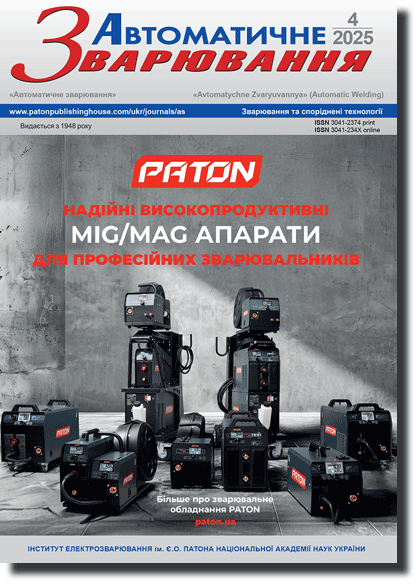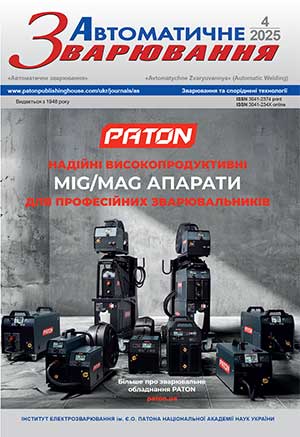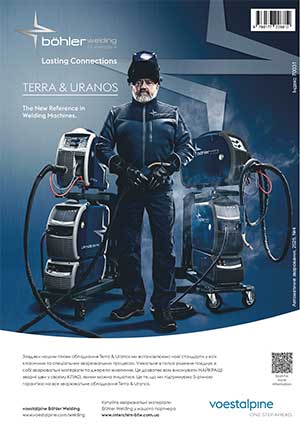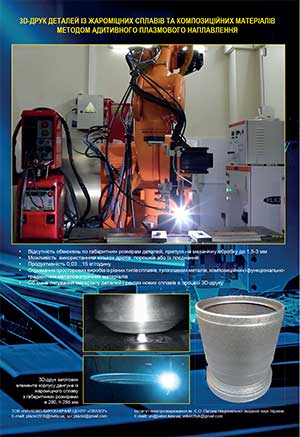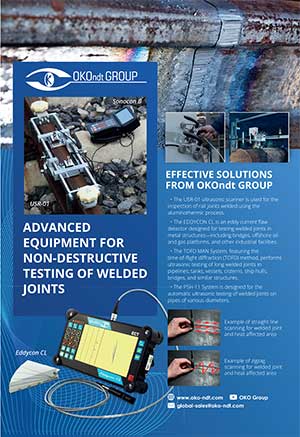| 2025 №04 (03) |
DOI of Article 10.37434/as2025.04.04 |
2025 №04 (05) |
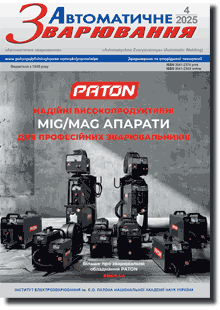
"Avtomatychne Zvaryuvannya" (Automatic Welding), #4, 2024, pp. 25-32
Mathematical modeling of thermal processes in friction stir welding of light alloys based on magnesium
O.O. Makhnenko, O.S. Kostenevych, O.V. Makhnenko
E.O. Paton Electric Welding Institute of the NAS of Ukraine 11 Kazymyr Malevych Str., 03150, Kyiv, Ukraine. E-mail: makhnenko@paton.kiev.uaMathematical modeling of thermal processes in welding is one of the effective methods for predicting the quality of a welded joint depending on technological parameters. However, to develop an adequate mathematical model, it is necessary to take into account a number of factors that can significantly affect the accuracy of the results of the computational analysis. Using the example of the problem of mathematical modeling of temperature distributions in friction stir welding (FSW) of a butt joint of plates of magnesium alloy MA2-1 (AZ31) of different thicknesses (2 mm and 8 mm), a computational study of the distribution of maximum temperatures and thermal cycles in points at different distances from the welded joint axis was carried out. It was found that the results of mathematical modeling of heat conductivity processes during welding heating in FSW are influenced by several aspects, among which one of the significant ones is heat dissipation to the working tool and the restraint devices. Also, to ensure the accuracy of calculation of temperature distributions during FSW, it is important to choose the optimal dimensions of the butt joint model in order to avoid the effect of heat accumulation in a model of a limited size, and to take into account the dependence of the friction coefficient on the temperature of the material, since its value determines the power of heat dissipation in FSW. Based on the results obtained, recommendations are formulated for conducting mathematical modeling of thermal processes in FSW of light alloys. 12 Ref., 4 Tabl., 11 Fig.
Keywords: friction stir welding, temperature distributions, thermal cycles, heat dissipation, work tool, backing plate, mathematical modeling, finite element analysis
Received: 08.04.2025
Received in revised form: 30.06.2025
Accepted: 31.07.2025
References
1. ISO/TS 18166:2016. Numerical welding simulation - Execution and documentation.2. Zhenzhen, Yu, Wei Zhang, Hahn Choo, Zhili Feng (2012) Transient heat and material flow modeling of friction stir processing of magnesium alloy using threaded tool. Metallurgical and materials transactions A, 43, 724-737. https://doi.org/10.1007/s11661-011-0862-1
3. Song, M., Kovacevic, R. (2004) Heat transfer modelling for both workpiece and tool in the friction stir welding process: a coupled model. Proc. Inst. Mech. Engrs., Part B: J. of Engineering Manufacture, 218(1), 17-33. https://doi.org/10.1243/095440504772830174
4. Majstrenko, A.L., Nesterenkov, V.M., Dutka, V.A., (2015) Modeling of heat processes for improvement of structure of metals and alloys by friction stir method. The Paton Welding J., 1, 2-10. https://doi.org/10.15407/tpwj2015.01.01
5. Gok, A., Aydin, M. (2013) Investigations of friction stir welding process using finite element method. The International J. of Advanced Manufacturing Technology, 68, 775-780. https://doi.org/10.1007/s00170-013-4798-z
6. Serindag, H.T., Kiral, B.G. (2017) Friction stir welding of AZ31 magnesium alloys - a numerical and experimental study. Latin American J. of Solids and Structures, 14(1), 113-130. https://doi.org/10.1590/1679-78253162
7. Tsaryk, B.R., Muzhychenko, O.F., Makhnenko, O.V. (2022) Mathematical model of determination of residual stresses and strains in friction stir welding of aluminium alloy. The Paton Welding J., 9, 33-40. https://doi.org/10.37434/tpwj2022.09.06
8. JMatPro® - Practical Software for Materials Properties. https://www.sentesoftware.co.uk
9. He Yang, Liang Huang, Mei Zhan (2011). Hot forming characteristics of magnesium alloy AZ31 and threedimensional FE modeling and simulation of the hot splitting spinning process. In: Magnesium Alloys - Design, Processing and Properties. By Czerwinski F. (Edited), pp. 367-388. https://doi.org/10.5772/13778
10. Khokhlov, М.А., Makhnenko, O.O., Kostin, V.A., Pokliatskyi, A.G., Falchenko, Iu.V., Khokhlova, Yu.A. (2024) Thermomechanical processes in friction stir welding of magnesium alloy sheets. Avtomatychne Zvaryuvannya, 3, 3-10 [in Ukrainian]. https://doi.org/10.37434/as2024.03.01
11. Larikov, L.N., Yurchenko, Yu.F. (1985) Structure and properties of metals and alloys: Thermal properties of metals and alloys. Handbook. Kyiv, Naukova Dumka [in Russian
12. Khairuddin, J. (2013) Development of multi component loads, torque and temperature measurement device for friction stir welding process. School of Mechanical Engineering Universiti Sains Malaysia. DOI: https://doi.org/10.13140/ RG.2.1.2165.0085
Advertising in this issue:
To order the electronic version of the paper:
O.O. Makhnenko, O.S. Kostenevych, O.V. MakhnenkoMathematical modeling of thermal processes in friction stir welding of light alloys based on magnesiumm
Automatic Welding №04 2025 p.25-32
The cost of article (pdf): 13 $, 12 €, 150 UAH (1 copy. )
fill in the form below:
The cost of subscription/purchase order journals or individual articles
| Journal/Currency | Annual Set | 1 issue printed |
1 issue |
one article |
| TPWJ/USD | 384 $ | 32 $ | 26 $ | 13 $ |
| TPWJ/EUR | 348 € | 29 € | 24 € | 12 € |
| TPWJ/UAH | 7200 UAH | 600 UAH | 600 UAH | 280 UAH |
| AS/UAH | 1800 UAH | 300 UAH | 300 UAH | 150 UAH |
| AS/USD | 192 $ | 32 $ | 26 $ | 13 $ |
| AS/EUR | 180 € | 30 € | 25 € | 12 € |
| SEM/UAH | 1200 UAH | 300 UAH | 300 UAH | 150 UAH |
| SEM/USD | 128 $ | 32 $ | 26 $ | 13 $ |
| SEM/EUR | 120 € | 30 € | 25 € | 12 € |
| TDNK/UAH | 1200 UAH | 300 UAH | 300 UAH | 150 UAH |
| TDNK/USD | 128 $ | 32 $ | 26 $ | 13 $ |
| TDNK/EUR | 120 € | 30 € | 25 € | 15 € |
AS = «Automatic Welding» - 6 issues per year;
TPWJ = «PATON WELDING JOURNAL» - 12 issues per year;
SEM = «Electrometallurgy Today» - 4 issues per year;
TDNK = «Technical Diagnostics and Non-Destructive Testing» - 4 issues per year.





